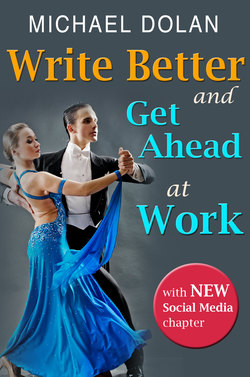Читать книгу Write Better and Get Ahead At Work - Michael Dolan - Страница 7
На сайте Литреса книга снята с продажи.
Using This Guidebook
ОглавлениеThe guidebook in your hands will show you how to identify and set goals for yourself so that writing becomes an enjoyable and effective experience for you at work. You will learn one very effective process for writing any memo, letter or report. This process relies on a format that organizes information on the page in a specific way. The format goes by this abbreviation: LEB123S. This acronym is not a cute, easy-to-remember name. Cute labels for writing formats, besides sounding contrived, make the job seem less demanding than it actually is. Neither is it a magic formula. It is a tool for you. You remain the center of the writing process, not this format. You use it; it does not command you.
The letters of the acronym stand for “Lead,” “Explanation,” “Background,” “First Example,” “Second Example,” “Third Example,” and “Summary.” When most people think about writing, they think about words on paper. Successful writers, however, know writing is more than what happens on the page. It is the research before and–for those who write at work–it is the response of readers afterwards that make writing enjoyable and productive.
The heart of this book—the LEB123S format—focuses directly on what happens on the page because that is the best way to communicate to people who want to improve their writing at work. Since that is where you are likely to start thinking about the subject, I will join you at that point and move on from there. The format then becomes a way to discuss the beginning of the writing process and a set of terms for examining the responses of prospective readers.
Once you learn how to organize the language on the page, you will learn ways to determine what content to include in your memos, letters and reports, and why.
But first we solve the most common problem I have seen in more than 25 years of editing and training people how to write. Too many writers shoot without selecting a target. They do not define exactly what success is. Instead, they wait for a vague sense of “rightness” or “flow” after committing words to paper. The sense never comes because it does not exist. Instead—and this is the best news in the guidebook—you are in charge. You determine what success is and you decide what to include in your writing at work. So the first activity is for you to write down what success is. Once you define what you want to achieve (select your target), you will discover a way to hit it. Only then will you experience that good feeling of doing a job well.
